|
Kingdom of Iraq Al-Mamlakah Al-'Irāqiyyah House of Al-Hashimi The Kingdom of Iraq (Arabic: المملكة العراقية
Al-Mamlakah Al-'Irāqiyyah) was the first modern state in Iraq, which began in August 1921 with the coronation of Faisal
bin al-Hussein bin Ali al-Hashemi as King Faisal I. Although a League of Nations mandate was awarded to Britain in 1920, the
1920 Iraqi revolt resulted in the mandate plan being dropped and a semi-independent kingdom being created under the Hashemite
allies of Britain. The kingdom was granted full independence in 1932 following the Anglo-Iraqi Treaty (1930). The kingdom
ended in 1958 when King Faisal II together with the Crown Prince were murdered and the monarchy was over thrown in a coup
led by Abd al-Karim Qasim. The House of Hashemite Hashemite is the Latinate version of the Arabic: هاشمي,
transliteration: Hāšimī, and traditionally refers to those belonging to the Banu Hashim, or "clan of
Hashim", a clan within the larger Quraish tribe. It also refers to an Arab dynasty whose original strength stemmed from
the network of tribal alliances and blood loyalties in the Hejaz region of Saudi Arabia, along the Red Sea. The Hashemites trace their ancestry from Hashim ibn Abd al-Manaf (died c. 510 AD),
the great-grandfather of the Islamic prophet Muhammad, although the definition today mainly refers to the descendants of the
prophet's daughter, Fatimah. The early history of the Hashemites saw them in a continuous struggle against the Umayyads for
control over who would be the caliph or successor to Muhammad. The Umayyads were of the same tribe as the Hashemites, but
a different clan. After the overthrow of the Umayyads, the Abbasids would present themselves as representatives of the Hashemites,
as they claimed descent from Abbas ibn Abd al-Muttalib, an uncle of Muhammad. Muhammad's father had died before he was born,
and his mother died while he was a child, so Muhammad was raised by his uncle Abu Talib, chief of the Hashemites. From the 10th century onwards,
the Sharif (religious leader) of Mecca and its Emir was by traditional agreement a Hashemite. Before World War I, Hussein
bin Ali of the Hashemite Dhawu-'Awn clan ruled the Hejaz on behalf of the Ottoman sultan. For some time it had been the practice
of the Sublime Porte to appoint the Emir of Mecca from among a select group of candidates. In 1908, Hussein bin Ali was appointed
Emir of Mecca. He found himself increasingly at odds with the Young Turks in control at Istanbul, while he strove to secure
his family's position as hereditary Emirs 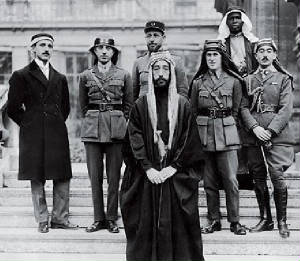
During and after
World War I Sharif Hussein bin Ali rebelled against the rule of the Ottomans during the Arab Revolt of 1916. Between 1917 and 1924, after the collapse of Ottoman power,
Hussein bin Ali ruled an independent Hejaz, of which he proclaimed himself king, with the tacit support of the British Foreign
Office. His supporters are sometimes referred to as "Sharifians" or the "Sharifian party". His chief rival
in the Arabian peninsula was the king of the highlanders on the highland of Najd named Ibn Saud, who annexed
the Hejaz in 1925 and set his own son, Faysal bin Abdelaziz Al Saud, as governor, the region was later incorporated into Saudi
Arabia. Hussein
bin Ali had five sons: - Ali,
who briefly succeeded to the throne of Hejaz before its loss to the Saud family.
- Abdullah, later became the king of Transjordan, and whose descendants rule
the kingdom, that has been known ever since as the Hashemite Kingdom of Jordan.
- Faisal, was briefly proclaimed King of Syria, and ended
up becoming King of Iraq.
- Prince Zeid, who moved to Jordan when his brother's grandson, King Faisal II of Iraq, was overthrown and
murdered in a coup in 1958.
- Hassan, died at a young age.
Royal Standard of the Kingdom of Iraq Iraq's first flag was inspired by the flag of the Kingdom of Hejaz, and was in use at the
time of independence in 1932. The flag was actually used before independence, from 1924 to 1959. 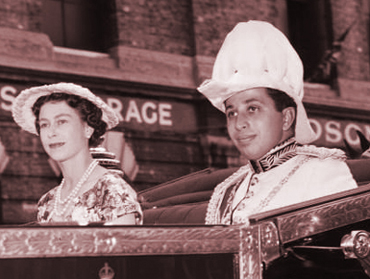
Hashemite
Kingdom of Iraq - 1921-1958 | Name | Lifespan
| Reign - start
| Reign - end
| Family
| King | Faisal I- Arabic: فيصل بن حسين بن
علي الهاشمي
| 20 May 1883 - 8 September 1933 | 23 August 1921 | 8 September 1933 | Hashemite |  | | Ghazi | 21 March 1912 - 4 April 1939 | 8 September 1933 | 4 April 1939 | Hashemite | | Faisal II- Arabic: الملك
فيصل الثاني
| 2 May 1935 - 14 July 1958 | 4 April 1939 | 14 July 1958 | Hashemite | |
The 14th July Revolution in Iraq In
the summer of 1958, King Hussein of Jordan asked for Iraqi military assistance during the escalating Lebanon crisis. Units
of the Iraqi Army under the command of Abd al-Karim Qasim, en route to Jordan, chose to march on Baghdad instead, where they
mounted a coup d'état on 14 July 1958. During the 14 July Revolution, Faisal II ordered the royal guard to offer no
resistance, and Faisal himself surrendered to the insurgents. Around 8 am, Captain Abdul Sattar Sabaa Al-Ibousi, leading the
revolutionary assault group at the palace, ordered the King, Crown Prince 'Abd al-Ilah, Princess Hiyam ('Abd al-Ilah's
wife), Princess Nafeesa ('Abd al-Ilah's mother), Princess Abadiya (Faisal's aunt) and several servants to gather in the
palace courtyard. Here, they were told to turn towards the wall, where all were immediately machine-gunned by their captors.
Faisal, who had not died during the initial fusillade, was transported to a hospital, but died en-route. Princess Hiyam survived
her injuries, caused during the massacre, and was able to escape the country. 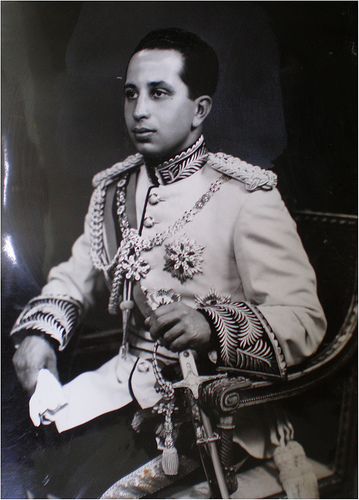 Nuri as-Said, Faisal's Prime Minister, was killed by Qassim's supporters
the following day. The monarchy was formally abolished, and control over the country passed to a tripartite "Sovereignty
Council," composed of representatives of Iraq's three major ethnic groups. A lengthy period of political instability
ensued, culminating in the ultimate triumph in 1963 of the Ba'ath Party, which in turn led to the eventual coming to power
of Saddam Hussein.
The Royal Family Titles and Styles Sovereign of Iraq: has the Title of King of Iraq, with the formal appellation of His Majesty,
wife of the Sovereign: has the Title of Queen of Iraq, with the formal appellation of Her Majesty, Heir Apparent: has the
Title of Crown Prince, with the formal appellation of His Royal Highness, sons of the Sovereign: have the Title of Amir -
Prince, with the formal appellation of His Royal Highness, daughters of the Sovereign: have the Title of Amira - Princess,
with the formal appelltion of Her Royal Highness, whereas other members of the Royal Family of Iraq: have the Titles of Amir
- Prince or Amira - Princess with the formal appellation of His or Her Highness, wives of Amirs, and the widows until they
remarry: are able to use the title of Amira - Princess together with the formal appellation borne by husbands. The Genealogy of The Royal House of Iraq 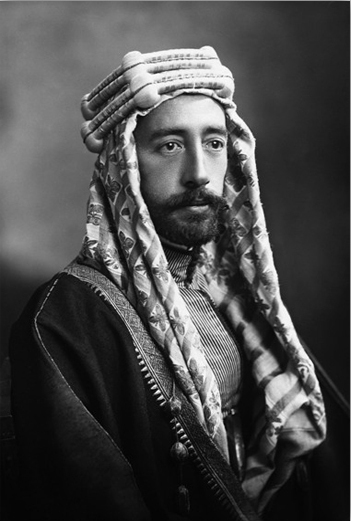 King of Iraq: 1921 - 1933 HM Faisal
I bin Hussein bin Ali al-Hashemi, (Arabic: فيصل بن حسين بن
علي الهاشمي Fayṣal ibn Ḥusayn; 20 May 1885 -
8 September 1933) was for a short time King of the Arab Kingdom of Syria or Greater Syria in 1920, and was King of the Kingdom
of Iraq (today Iraq) from 23 August 1921 to 1933. He was a member of the Hashemite dynasty. Faisal encouraged overcoming
cleavage between Sunni and Shiite to foster common loyalty and promote pan-Arabism in the goal of creating an Arab state that
would include Iraq, Syria and the rest of the Fertile Crescent. While in power, Faisal tried to diversify his administration
by including different ethnic and religious groups in offices. He faced great challenges in achieving this because the region
was under European, specifically French and British, control and other Arab leaders of the time were hostile to his ideas
as they pursued their own political aspirations for power. In addition, Faisal's attempt at pan-Arab nationalism inevitably
isolated certain religious groups. 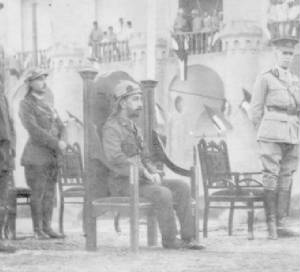 Faisal was born in Ta'if (in present-day Saudi Arabia) in
1883, the third son of Hussein bin Ali, Sharif of Mecca, the Grand Sharif of Mecca. He grew up in Constantinople and learned
about leadership from his father. In 1913, he was elected as representative for the city of Jeddah for the Ottoman parliament. In
1916, on a mission to Istanbul, he visited Damascus twice. On one of these visits he received the Damascus Protocol, joined
with the Al-Fatat group of Arab nationalists, and his father became king of Hejaz. Faisal was married to Hazima bint Nasser and had one son and
three daughters: - Princess
Azza bint Faisal
- Princess
Rajiha bint Faisal
- Princess
Raifia bint Faisal
- Ghazi,
King of Iraq born 1912 died 4 April 1939, married Princess Aliya bint Ali daughter of HM King Ali of Hejaz.
King of Iraq: 1933 - 1939 HM King Ghazi I (Arabic: غازي ابن
فيصل Ġāzī bin Fayṣal) (March 21, 1912 - April 4, 1939) was the King of the
Hashemite Kingdom of Iraq from 1933 to 1939 having been briefly Crown Prince of the Kingdom of Syria in 1920. He was born
in Mecca (in present-day Saudi Arabia), the only son of Faisal I, the first King of Iraq. 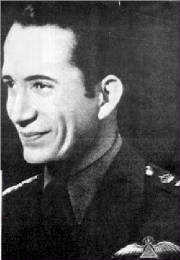 On 8 September 1933, King Faisal I died, and Ghazi was crowned
as King Ghazi I. On the same day, Ghazi was appointed Admiral of the Fleet in the Royal Iraqi Navy, Field Marshal of the Royal
Iraq Army, and Marshal of the Royal Iraqi Air Force. A staunch pan-Arab nationalist, opposed to British interests in his country,
Ghazi's reign was characterized by tensions between civilians and the army, which sought control of the government. He supported
General Bakr Sidqi in his coup, which replaced the civilian government with a military one. This was the first coup d'état
to take place in the Arab world. He was rumored to harbor sympathies for Nazi Germany and also put forth a claim for Kuwait
to be annexed to Iraq. For this purpose he had his own radio station in al-Zuhoor royal palace in which he promoted that claim
and other radical views. Ghazi died in 1939 in a mysterious accident involving a sports car he was driving. Some
believe he was killed on the orders of Nuri as-Said. Faisal, Ghazi's only son, succeeded him as King Faisal II. Because
Faisal was under age, Prince Abdul Ilah served as Regent until 1953. 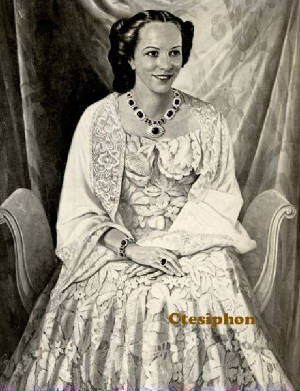 On January 25, 1934 Ghazi married
Princess Aliya bint Ali daughter of King Ali of Hejaz in Baghdad Iraq. They had only one son: - Faisal II, King of Iraq - born May 2, 1935 died July
14, 1958
King of Iraq: 1939 - 1958 HM
Faisal II (Arabic: الملك فيصل الثاني
Al-Malik Fayṣal Ath-thānī) (May 2, 1935 - July 14, 1958) was the last King of Iraq. He reigned from 4 April
1939 until July 1958, when he was killed during the "14 July Revolution" together with several members of his family.
Faisal's regicide marked the end of the thirty-seven year old Hashemite monarchy in Iraq, which became a republic. Faisal was the only son of Iraq's second king, Ghazi, and
his wife Queen Aliya, second daughter of 'Ali bin Hussein, King of the Hijaz and Grand Sharif of Mecca. His father was killed
in a mysterious car crash when Faisal was three years old; Faisal's uncle 'Abd al-Ilah served as regent until he came of age
in 1953. Faisal was first betrothed to Princess Kıymet Hanım,
a descendant of the last Mamluk dynasty of Iraq, in January 1958. This engagement was called off three months later. Faisal
then asked for the hand of Princess Shahnaz Pahlavi, daughter of the Iranian Shah Muhammad Reza Shah, but was turned down
by Shahnaz. At the time of his death, King Faisal was engaged to be married to HH Princess Sabiha Fazila Hanım Sultan,
the only daughter of HE Damat HH Prince Muhammad 'Ali Ibrahim Beyefendi of Egypt and HIH Princess Zahra Hanzade Sultan.
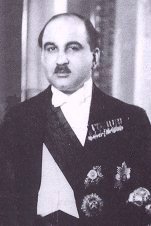 Head of Royal House: 1958 - 1970 Prince Zeid bin Hussein, GCVO, GBE (Arabic: الأمير زيد
بن الحسين) born (February 28, 1898 - October 18, 1970) was a member of
the Hashemite dynasty and the head of the Royal House of Iraq from 1958 until his death and had issue*. Prince Zeid was the
only son of King Hussein of Hejaz and his third wife Adila Khanum. He was educated at Ghalata Serai (Galatasaray High School)
College, Constantinople College and Balliol College, Oxford. From 1916 - 1919, Prince Zeid was the Commander of the Arab Northern
Army. In 1918 T. E. Lawrence suggested that he be made King of a truncated Syria. The advent of French rule resulted in his
1923 assignment to the Iraqi Cavalry and he was promoted to Colonel. Zeid was also Iraqi ambassador in Berlin and in Ankara
in 1930s and in London in the 1950s. On July 14, 1958, Prince Zeid was appointed Head of the Royal House of Iraq, following
the assassination of his great-nephew King Faisal II by General Muhammad Najib ar-Ruba'i, who proclaimed Iraq to be a Republic.
Zeid and his family continued to live in London, where the family resided during the coup, as Zeid was the Iraqi ambassador
there. Prince Zeid died in Paris on October 18, 1970, and is buried in the Royal Mausoleum at Raghdan Palace, Amman, Jordan.
His son Prince Ra'ad succeeded him as head of the Royal House of Iraq.
*HRH Prince Ra'ad
bin Zeid - born February 18, 1936, married to Margaretha Inga Elisabeth Lind, now Majda Raad.
 Head of Royal House: 1970-
Prince Ra'ad bin Zeid (Arabic: الأمير رعد بن زيد)
(born 18 February 1936 in Berlin where his father was Iraqi ambassador at the time) is the son of Prince Zeid of the Hashemite
House and Princess Fahrelnissa Zeid (Fakhr un-nisa), a Turkish noblewoman. Upon the death of his father on October 18, 1970,
he inherited the position as head of the Royal Houses of Iraq and Syria. Ra'ad has lived in London and Paris. The Kingdom
of Jordan has confirmed his style as His Royal Highness and Prince and has issue. HRH Prince Zeid bin Ra'ad - born January 26, 1964, married to Sarah Butler. (Now HRH Princess
Sarah Zeid.) They have 2 children, HH Prince Ra'ad bin Zeid (Born: 17 May 2001.) and HH Princess Hala bint Zeid. (Born: 13
March 2003.) HRH Prince
Mired bin Ra'ad - born January 11, 1965, married to Dina Khalifeh. (Now HRH Princess Dina Mired.) They have 3 children,
HH Princess Shirin bint Mir'ed. (Born: 19 May 1993) HH Prince Rakan bin Mir'ed (Born: 20 November 1995) and HH Prince Jafar
bin Mir'ed. (Born: 4 September 2002.)HRH Prince Firas bin Ra'ad - born October 12, 1969, married to Dana Toukan. (Now HRH Princess Dana
Firas.) They have 2 children, HH Princess Safa bint Firas (Born: 26 July 2001.) and HH Princess Haya bint Firas. (Born: 7
March 2003)HRH Prince
Faisal bin Ra'ad - born March 6, 1975, graduated from Brown University, and married to Lara Sukhtian. (Now HRH Princess
Lara Faisal.) She worked with MSNBC news in Baghdad covering the Iraq war. She's the daughter of Munjid Sukhtian. They have
2 children, HH Princess Hanan bint Faisal (Born: 3 September 2006) and HH Princess Mariam bint Faisal. (Born: 25 July 2008)
HRH Princess Fakhrelnissa bint Ra'ad -
born January 11, 1981, married to Sharif Hajjar. They have 2 children, Radwan Hajjar (Born: 8 August 2006.) and Faisal Hajjar.
(Born: 14 December 2007) Heir to Headship of Royal House: Prince Zeid Ra'ad Zeid Al-Hussein was born 26 January 1964 in Amman, Jordan to Prince Ra'ad bin Zeid head of
the Royal Houses of Iraq and Syria and pretender to the Iraqi throne and his Swedish-born wife Margaretha Inga Elisabeth Lind,
henceforward known as Majda Raad. He is Jordan's Permanent Representative to the United Nations, a post he already held previously
for six and a half years (2000-2007). From 2007-2010 he served as Jordan's Ambassador to the United States and non-resident
Ambassador to Mexico. Prince Zeid was married on the 5 July 2000 at Amman to Sarah Butler and has issue.
HH Prince Ra'ad - born 17 May 2001HH Princess Hala - born 13 March 2003
|

